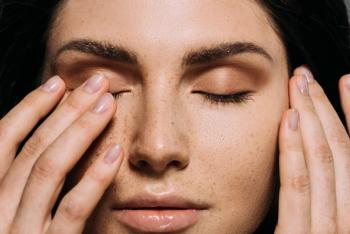
The Effect of Ceramide Products on Dry Legs
A study in the Journal of Drugs in Dermatology dove into the effect of ceramide-containing products on stratum corneum lipid levels in dry legs.
A study in the
The researchers investigated the efficacy of a multilamellar vesicular emulsion (MVE), ceramide-containing moisturizing cream in a randomized, investigator-blinded, split-leg study on female subjects with dry, itchy skin. The study enrolled 53 female patients with Fitzpatrick skin types I-VI who signed informed consent (Concordia Institutional Review Board). There were 26 patients from 30 to 50 years old. Of that number, 27 were 51 to 63 years old. All patients were then categorized with the descriptors dry to very dry skin, skin texture roughness (visual/tactile), desquamation/ flakiness, lack of radiance/dull skin, and erythema on the lower legs.
They also completed an assessment of itch on a 5-point scale. There were 29 patients self-identified as having mild to moderate itchy skin on both legs (a score of 2 to 3). The patients also kept track of their hair removal routines in diaries and were given glycerin cleansing bars (Neutrogena, Johnson & Johnson, and Skillman) to replace body soap.
The study moisturizer contained glycerin and hyaluronic acid to function as humectants to increase skin water content and dimethicone as an occlusive agent to maintain the increased water content in the skin. Also included were emollients, such as caprylic/capric triglyceride, cetearyl alcohol, and ceteareth-20, to smooth rough skin created by improperly desquamating corneocytes. Study product differentiators included cholesterol, phytosphingosine, and ceramides 1, 3, and 6-II, which are all components of the intercellular barrier lipids.
Overall, 50 of the 53 enrolled patients completed the study. After a corneometry was used to assess the skin's water content, it was found that after 3 days of study product use, there was a 30.6% increase in the treated vs the untreated leg (P < .001). At week 4, this trend continued showing a 38% water content increase in the treated vs untreated leg (P < .001) and was maintained in the regression phase where the skin had no moisturizer applied with a statistically significant 21.85% increase (P < .01).
The investigator assessment found highly statistically significant improvement in skin dryness, skin texture/roughness (tactile), skin texture/roughness (visual), desquamation/flakiness, luminosity/radiance, and overall appearance of healthy skin on the treated leg compared to the untreated leg (P < .001), the article explained.
The patients found that there was a statistically significant reduction in stinging (P = .008), burning (P = .001), and itching (P < .001) in the leg receiving the study’s product. This achieved a 60% reduction in itching, a 55% reduction in burning, and a 42% reduction in stinging and continued throughout the 4-week study and into the 48-hour regression period.
The D-Squame lipid analysis after 4-weeks of moisturizer application saw a 10% increase in total skin ceramide content in the treated skin vs the untreated. Also, there was a 10% increase in both the cholesterol and free fatty acids levels. “This reflects a significant increase (P < .01) in skin barrier lipid content at 4-weeks,” the authors wrote. These results were maintained after the 48-hour discontinuation (P = .025).
“These results and those from the stratum corneum lipid analysis are evidence for the benefits of using the studied ceramide-containing moisturizer for dry skin even in warmer, high-humidity conditions,” the authors concluded.
Reference:
The effect of a ceramide-containing product on stratum corneum lipid levels in dry legs. JDDonline - Journal of Drugs in Dermatology. Accessed December 20, 2021. https://jddonline.com/articles/the-effect-of-a-ceramide-containing-product-on-stratum-corneum-lipid-levels-in-dry-legs-S1545961620P0372X/
Newsletter
Like what you’re reading? Subscribe to Dermatology Times for weekly updates on therapies, innovations, and real-world practice tips.

















